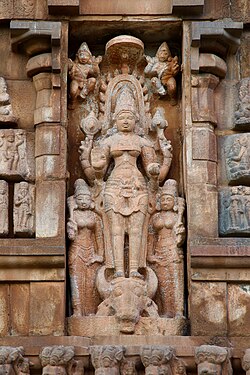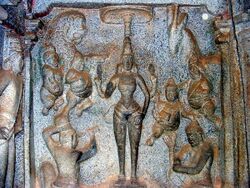Religion:Korravai
Kotṟavai (Tamil: கொற்றவை, Script error: The function "transl" does not exist.), also spelled Kotravai or Korravai, is the goddess of war and victory in the Tamil tradition. She is also the mother goddess and the goddess of fertility, agriculture, and hunters. In the latter form, she is sometimes referred to by other names and epithets in the Tamil tradition of Tamilnadu and Sri Lanka, such as Atha, Mari, Suli, and Neeli.[1][2] She is considered as Mother of Tamil god Murugan in the Tamil traditions of Tamilnadu and Sri Lanka.
She is merged with the Hindu goddess of power, Parvati[3] in the mythologies created in later centuries.
She is among the earliest documented goddesses in the Tamil Sangam literature, and also found in later Tamil literature. She is mentioned in the many poems in Paripāṭal, though the dedicated poem to her in among those that have been lost to history.[4][5] She is mentioned in the Pattuppattu anthology – the long Tamil poems dated between 300 BCE to 300 CE, including the Neṭunalvāṭai, Maturaikkanci, Poruṇarāṟṟuppaṭai, and Paṭṭiṉappālai.[6] In the Tamil epic Silappadikaram (c. 2nd-century), she is said to be the goddess of the Pālai region.
Her name is derived from the Tamil word korram, which means "victory, success, bravery".[7] The earliest references to Kotravai are found in the ancient Tamil grammar Tolkappiyam, considered to be the earliest work of the ancient Sangam literature.
She is also seen as a mother goddess, a symbol of fertility and success in agriculture.[8] Traditional rural communities offer the first harvest to her.[9] As war goddess who is blood thirsty, some texts such as the Silappadikaram and Agananuru mention that warrior devotees would, in a frenzy, offer their own head to the goddess.[9]
In Tamil Nadu, the blackbuck (Kalaimaan) is considered to be the vehicle of the Tamil goddess Korravai [10][11] She is sometimes shown as riding a lion, as in the 7th-century mandapam of the Group of Monuments at Mahabalipuram, Tamil Nadu. Both the lion and blackbuck is shown with a standing Korravai in a rock-relief panel at the Varaha mandapam of Mahabalipuram.[12]
She is depicted as a deity with several arms holding different weapons. She is said to be mother of the Tamil god Murugan. Animal sacrifices and dancing rituals are a part of the worship of this goddess.
Notes and references
- ↑ Barbara Schuler (2009). Of Death and Birth: Icakkiyamman, a Tamil Goddess. Otto Harrassowitz Verlag. pp. 28 with note 1.1. ISBN 978-3-447-05844-5. https://books.google.com/books?id=wj76rDfgTCYC&pg=PA28.
- ↑ Nicholapillai Maria Saveri (1993). A Catholic-Hindu Encounter: Relations Between Roman Catholics and Hindus in Jaffna, Sri Lanka, 1900-1926. Centre for Performing Arts. p. 170. https://books.google.com/books?id=wBXZAAAAMAAJ.
- ↑ (in en) Asian Folklore Studies. Nanzan University Institute of Anthropology. 1984. pp. 140. https://books.google.com/books?id=savhAAAAMAAJ&q=kotravai+parvati.
- ↑ Elizabeth Rani Segran (2012). The River Speaks: The Vaiyai Poems from the Paripatal. Penguin Books. p. 47. ISBN 978-81-8475-694-4. https://books.google.com/books?id=DnwruNVgFUkC&pg=PT47.
- ↑ Ca. Vē Cuppiramaṇiyan̲; R. Vijayalakshmy (1983). Philosophical Heritage of the Tamils. International Institute of Tamil Studies. p. 138. https://books.google.com/books?id=5gnRAAAAMAAJ.
- ↑ JV Chelliah (1946), Pattupattu - Ten Tamil Idylls (Tamil Verses with Englilsh Translation), Tamil University (1985 print), pp. xv–xxvi, 1–12
- ↑ Zvelebil, Kamil (1992). Companion Studies to the History of Tamil Literature. BRILL. pp. 21–22 with footnotes. ISBN 90-04-09365-6. https://books.google.com/books?id=qAPtq49DZfoC.
- ↑ R. Mahalakshmi (2011). The Making of the Goddess: Kor̲r̲avai-Durgā in the Tamil Traditions. Penguin Books. pp. 1–7, Chapter 1 and 2. ISBN 978-0-14-341742-2. https://books.google.com/books?id=Z7R9tgAACAAJ.
- ↑ 9.0 9.1 Vijaya Ramaswamy (2017). Historical Dictionary of the Tamils. Rowman & Littlefield Publishers. pp. 195–196. ISBN 978-1-5381-0686-0. https://books.google.com/books?id=ALUvDwAAQBAJ.
- ↑ van der Geer, A. (2008). Animals in Stone : Indian Mammals Sculptured through Time. Leiden, South Holland (Netherlands): Brill. pp. 57–58. ISBN 9789004168190. https://archive.org/details/animalsstoneindi00geer.
- ↑ Krishna, N. (2010). Sacred Animals of India. New Delhi, India: Penguin Books India. ISBN 9780143066194.
- ↑ Harle, James (1963). "Durgā, Goddess of Victory". Artibus Asiae 26 (3/4): 237–246. doi:10.2307/3248984.
Bibliography
- Mahalakshmi, R. (2009). "Caṇkam literature as a social prism: an interrogation". Chapter 3 (29–41) in Brajadulal Chattopadhyaya (editor). A Social History of Early India. Pearson Education, India.
- Harle, James C. (1963). "Durgā, Goddess of Victory". Artibus Asiae 26 (3/4): 237–246. doi:10.2307/3248984.
- Kersenboom-Story, Saskia C. (1987). Nityasumaṅgalī: devadasi tradition in South India. Motilal Banarsidass.
- Kinsley, David R. (1988). Hindu goddesses: visions of the divine feminine in the Hindu religious tradition. Hermeneutics: Studies in the History of Religions 12. University of California Press.
- Tiwari, Jagdish Narain (1985). Goddess Cults in Ancient India (with special reference to the first seven centuries A.D.). Sundeep Prakashan. [Adapted from his PhD thesis accepted by the Australian National University in 1971.]
 |




